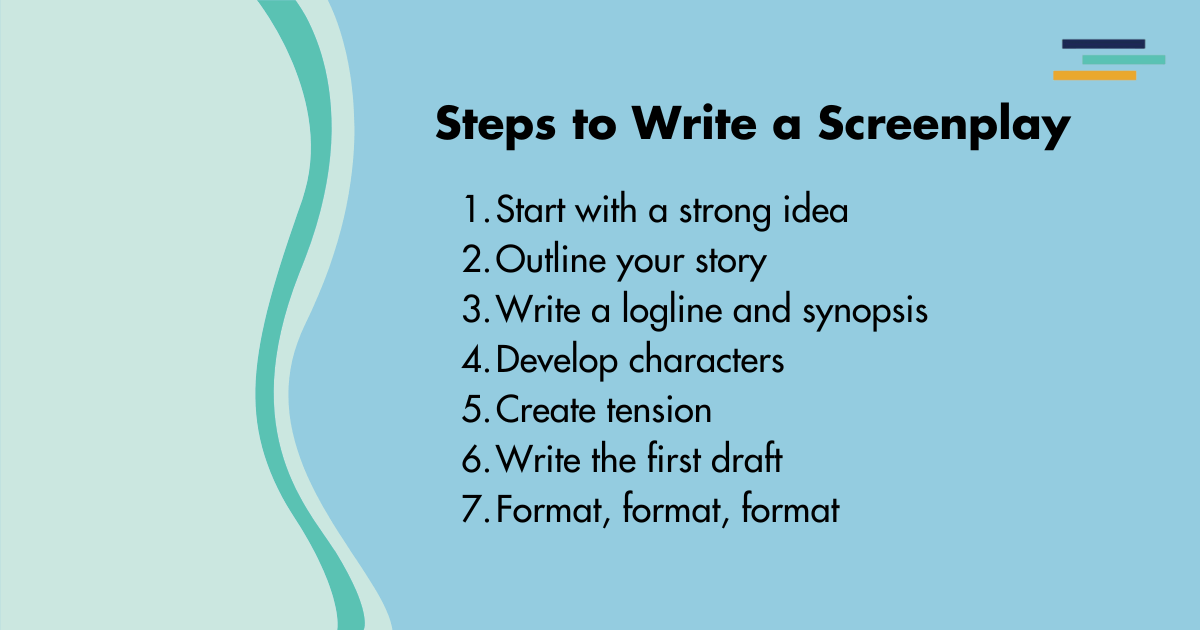
So, you’ve got a brilliant idea that you think would make an incredible movie.
Now comes the challenge of transforming that idea into a screenplay. But what exactly is a screenplay, and how do you go about writing one?
Fantastic questions.
I’ve got answers.
Whether you’re a complete beginner or a seasoned storyteller looking to break into screenwriting, this article will cover everything you need to know, from defining what a screenplay is to offering tips that will help your writing shine on screen.
What Is a Screenplay?
A screenplay, in its simplest form, is the blueprint for a movie.
It’s a written document that outlines the story, characters, dialogue, and actions that will unfold on screen.
But more than that, a screenplay is a tool that helps filmmakers, producers, and actors visualize the film long before the cameras roll. It’s both art and architecture, combining the creativity of storytelling with the precision needed to communicate with an entire production team.
Define Screenplay
A screenplay is a written work that details every visual, aural, action, and dialogue element needed to tell a story for the screen.
Think of it as the instructions for a film, guiding everyone involved—from the director to the actors—on how the story should unfold. Screenplays are typically written in a specific format, with clear rules for how scenes, dialogue, and actions get presented.
These guidelines ensure clarity and ease of understanding for all involved in the production process.
Screenplay Meaning
The meaning behind a screenplay goes beyond just words on a page.
It’s the core vision of the film, capturing the heart of the story and the characters while setting the stage for how it will look and feel on screen.
For screenwriters, it’s about balancing telling an interesting story and providing enough detail for the production team to translate that story into a visual medium. Screenplays are often the first step in a film’s journey from concept to finished product.

The Importance of Research in Screenwriting
Even if your screenplay takes place in a galaxy far, far away, research is a vital part of the process.
Whether you’re writing historical drama, gritty crime thriller, or space opera, your story needs to feel authentic to its world.
If your characters are doctors, for example, understanding medical jargon and procedures helps to avoid inaccuracies that might pull your audience out of the story. If your setting is 1940s New York, knowing the cultural context of the time will help you create a more immersive atmosphere.
Research isn’t just about facts, though. It’s also about understanding the emotional truth of your characters’ journeys.
Watching films in your genre, reading screenplays, and diving into the worlds of your characters can make your screenplay richer and more believable. Your audience will feel more connected to the world you’ve built when it’s rooted in reality…
Even if that reality involves talking robots.
Understanding the Three-Act Structure
The three-act structure is the backbone of most screenplays. It’s a tried-and-true formula that helps guide your story from start to finish while keeping the audience engaged.
The structure is divided into three key parts:
- Act 1: The Setup—This is where you introduce the world, your characters, and the conflict. By the end of Act 1, your protagonist should face a challenge or choice that propels them into the major conflict.
- Act 2: The Confrontation—Often the longest part of the screenplay, Act 2 is where you raise the stakes, obstacles arise, and your protagonist struggles to overcome challenges. This act is all about building tension and deepening the conflict.
- Act 3: The Resolution—In Act 3, everything comes to a head. Your protagonist faces their ultimate challenge, and you resolve the story’s conflicts. Whether it’s a happy ending or a tragic one, Act 3 ties up the narrative threads you’ve been weaving.
Understanding and embracing this structure can make writing your screenplay more manageable, ensuring your story has a natural flow that builds towards a satisfying conclusion.
Screenplay Genres and How They Shape Your Writing
Each genre has its own set of conventions and expectations, which deeply influence how you write your screenplay. Whether you’re writing a thriller, a romantic comedy, or a sci-fi epic, understanding the genre you’re working in will shape your choices in pacing, tone, and character development.
For example, thrillers rely heavily on building tension and keeping the audience on the edge of their seat. Pacing is often quick, with scenes that escalate stakes and create a sense of urgency. Dialogue is sharp and to the point, with characters often caught in high-pressure situations.
Romantic comedies need a lighter touch. Dialogue is witty, character-driven, and often centered on misunderstandings or banter. The pacing is slower, allowing space for emotional beats and character development to shine.
Horror screenplays focus on atmosphere and tension, using visual and auditory elements to create fear. The aim is to build suspense through silence, jump scares, or psychological unease.
Meanwhile, a fantasy screenplay allows for grand world-building, with scenes that establish intricate settings, magic systems, and epic quests.
Understanding your genre not only helps you meet audience expectations but also gives you the creative freedom to bend or break those rules in a way that makes your screenplay unique.
7 Steps to Write a Screenplay
Writing a screenplay may seem daunting at first, but breaking the process down into manageable steps makes it far more approachable.
Here’s a step-by-step guide to help you get started on your screenwriting journey:
Step 1: Start with a Strong Idea
Every screenplay begins with an idea, whether it’s a unique concept, an intriguing character, or an interesting setting.
Before you dive into writing, take the time to fully develop your idea. Ask yourself questions like:
- What is the major conflict?
- Who are the key characters?
- What’s the goal or message of the story?
Having a clear vision before you write will save you countless hours down the line.
Step 2: Outline Your Story
Once you’ve nailed down your idea, it’s time to outline your story.
This is where you break down the key beats of your narrative, including the beginning, middle, and end. A screenplay typically follows a three-act structure, where Act 1 introduces the characters and conflict, Act 2 develops the tension and challenges, and Act 3 resolves everything.
Creating a detailed outline allows you to visualize the full arc of your story and ensures that your plot stays on track.
Step 3: Write a Logline and Synopsis
Before writing your full screenplay, draft a logline (a one-sentence summary of your story) and a synopsis (an outline of the major plot points).
The logline should capture the essence of your story and intrigue potential readers, while the synopsis gives a more detailed overview. These two elements are crucial for pitching your screenplay to producers and agents, and they also help clarify your story’s focus before you write.
Step 4: Develop Your Characters
Marvellous stories are driven by great characters.
Take time to fully flesh out your protagonists, antagonists, and supporting characters.
Consider their motivations, desires, and flaws—what drives them forward, and what stands in their way? Character development is key to keeping your audience invested, so ensure that your characters grow and develop throughout the screenplay.

Step 5: Create Tension and Build Stakes
One of the most crucial elements of any screenplay is tension. Without it, your story will fall flat.
Tension keeps the audience glued to their seats, eager to see what happens next. But how do you create and maintain tension throughout your script?
It starts with stakes.
The higher the stakes, the more invested your audience will be in the outcome.
Every scene should either raise the stakes or increase the tension. Whether it’s a life-or-death situation or a more personal dilemma, make sure your characters have something to lose.
Conflict—both external and internal—drives tension.
Put your characters in difficult situations that challenge them, and let the audience worry about whether they’ll make it out. And remember, tension isn’t just about action sequences. You can build it through quiet moments of emotional conflict or suspense.
Step 6: Write the First Draft
Now comes the fun part…
Writing the first draft.
Don’t worry about getting everything perfect at this stage. The goal here is to get your ideas on paper and create a rough version of your screenplay.
Focus on writing dialogue, setting up scenes, and following the flow of your outline. Remember, this is just the first draft, and revisions will come later, so allow yourself some creative freedom.
Step 7: Format Your Screenplay Correctly
Formatting is crucial in screenwriting.
Screenplays follow a specific format that includes standard font size, margin widths, and formatting for scene headings, action lines, and dialogue.
Use screenwriting software like Final Draft or Celtx to ensure your screenplay adheres to industry standards. Proper formatting makes your script easier to read and shows professionalism to producers and agents.
Step 8: Edit and Revise
Once your first draft is complete, it’s time to edit and revise.
Screenwriting is all about clarity and economy of language. Cut any unnecessary dialogue or scenes that don’t drive the plot forward. Look for areas where you can show instead of tell and make sure every line serves a purpose.
It may take several rounds of revisions, but that’s part of the process.
Tips For Writing a Screenplay
Screenwriting requires a unique blend of storytelling, visual thinking, and technical precision. Here are some essential tips to help improve your screenwriting skills and ensure your screenplay stands out.
Focus on Visual Storytelling
Screenplays are a visual medium, so think about how your story will translate on screen.
Instead of relying on lengthy descriptions or internal thoughts, focus on what the audience will see.
Use action lines to set the scene and communicate the mood or tone of a moment. Remember, a film’s visuals are just as important as its dialogue.
Write Strong Dialogue
Dialogue in screenplays should be concise, purposeful, and reveal character.
Great dialogue isn’t just about what characters say but how they say it. Each character should have a unique voice, reflecting their personality and background. Avoid over-explaining through dialogue.
Use subtext and let the audience infer meaning from context.
Use Subtext in Dialogue
In screenwriting, what characters don’t say is often more important than what they actually say.
Subtext—the meaning behind the words—adds layers of complexity to your dialogue, letting your characters communicate on multiple levels. Skilled screenwriters use subtext to show the audience what the characters are thinking and feeling without directly stating it.
For example, imagine a scene where two characters argue about something trivial, like a parking ticket.
On the surface, it’s a mundane conversation, but the subtext reveals that the argument is really about something deeper, like:
- Resentment
- Jealousy, or
- Fear
Audiences pick up on this, making the scene more engaging. By using subtext, you can make your dialogue richer, more realistic, and emotionally resonant.
Embrace Structure
Screenwriting is heavily reliant on structure, so embrace the three-act structure to give your screenplay a sound foundation.
Act 1 sets up your world and introduces the conflict, Act 2 escalates the stakes, and Act 3 brings the story to its resolution. Sticking to this structure doesn’t mean your story will be predictable. It simply ensures your screenplay flows smoothly and keeps the audience engaged.
Use Fictionary Live! Courses to Improve Your Writing
Fictionary Live! offers a range of six-week courses that improve all aspects of your storytelling. Whether you’re working on the structure of your screenplay or refining specific scenes, these courses provide live guidance from professional StoryCoach Instructors.
With courses like Write Sensational Scenes and Story Foundations, you’ll learn how to craft stronger narratives, structure your plot effectively, and develop memorable characters.
The live sessions are interactive, so you’ll get real-time feedback on your work and improve your screenplay step by step.
Fictionary Live! Six-Week Courses (Premium subscribers only).
As a Premium Subscriber, you’ll work on your story with support from StoryCoach Instructors.
Stay focused and on track with our six-week live online courses, including:
- Story Foundations: Start Your Story with 5 Must-Have Scenes
- From Sparks to Soulmates: A Deep Dive into Romance Structure
- Forge Your Fantasy: A Deep Dive into Fantasy Structure
- Series Foundations: Structure Your Entire Book Series
- Write Sensational Scenes: Discover the Power of Deep Structure
- Novel Editing Part 1: Identify Issues and Create a Revision Plan
- Novel Editing Part 2: Revise and Finish Your Story
Keep Your Audience in Mind
While writing your screenplay, constantly think about the audience.
Will they care about these characters? Will the story’s stakes feel real and urgent to them? Screenwriting is about connecting with an audience on an emotional level, so ensure that each scene serves the story and engages the viewer.
Be Open to Feedback
Screenwriting, like all forms of writing, is a process that benefits from feedback.
Share your screenplay with trusted beta readers or writing groups and be open to their insights.
Sometimes an outside perspective can highlight issues or provide ideas for improvement you haven’t considered. The best screenplays often go through multiple drafts before they’re ready for production.
Collaborating with Directors and Producers
Screenwriting is a collaborative art form.
As a screenwriter, your script is the foundation of a film, but it’s only one piece of the puzzle.
Directors, producers, and sometimes actors will all have input into how they bring your story to life on screen. Understanding this dynamic is essential for screenwriters.
When working with directors and producers, be open to feedback and flexible with your vision. While it’s important to stay true to the heart of your story, filmmaking is a team effort, and compromise is often necessary. Collaboration can lead to exciting new ideas and directions that often means embracing the creative contributions of others.
By following these steps and tips, you’ll be well on your way to creating a screenplay that’s ready for the big screen.
Screenwriting may seem challenging at first, but with patience, practice, and the right tools—like the Fictionary Live! courses—you can turn your ideas into a fully realized story.
And finally, always remember that the story comes first. Focus on:
- Creating engaging characters
- Penning interesting plots
- Structuring solid settings
A tool like Fictionary helps you turn your draft into an interesting story readers love. So, with a strong narrative foundation, your writing can truly shine.


